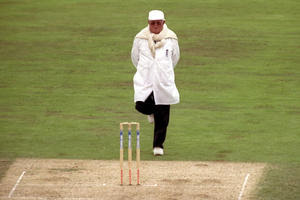
There are generally two umpires in the game of cricket. One of these umpires generally stands at the bowler’s end that is behind the wicket. The second umpire generally stands in a position called ‘square leg’. This position is approximately at a distance of 15 to 20 meters from the striking batsman. The umpire who is on the bowler’s end is generally between the bowler and the non-striking batsman at the time when the bowler is delivering the ball. In case the umpire does not find the playing conditions suitable for the game, he can take the decision of postponing the match and he can ensure that all the players are off the field. This could happen under the natural weather conditions characterized by the presence of rain or poor lighting conditions.
There is also another umpire called the third umpire. He plays a very important role under special circumstances wherein the final decision is left to be made by the third umpire who generally makes a decision by making use of video evidence. The presence of a third umpire is necessitated particularly in test cricket and in the limited overs internationals wherein the match is being played the by the full members of ICC. A match referee is also a part of these games who makes sure that all the laws of cricket are being followed during a particular cricket match and also the spirit of game is being maintained.

The details of a cricket match including the dismissals and runs are recorded by the two officially appointed scorers who are generally off the field. Most of the scorers are generally directed by the hand signals of an umpire. Thus, when an umpire raises both his arms above his head, then the official scorer gets the indication that the batsman has scored six runs.
It is important for the official scorers to maintain the details of the game and record the score as per the laws of cricket. The official scorers also record runs scored, wickets taken and also the overs bowled. There is other information also that is recorded by these scorers such as bowling analysis and run rates. In comparison to the other sports, cricket scoring can be described as much more intricate in nature. This is because it requires much more details to be recorded. Cricket scoring needs to be ensured not just for the runs but also for the wickets.
It is also important to record those circumstances where runs have not been taken. Cricket scoring involves the basic premise of making a record of the number of runs that have been scored vis-à-vis the number of wickets that have fallen for the team members of the batting. The scorer is also required to record that which bowler on the fielding side is actually responsible for taking the wicket. He has carefully note down all details and must ensure to record the all runs that are attributed to batsmen and all wickets which are attributed to the bowlers.
Original Source: http://sportsarticlesonly.com/cricket/the-roles-of-umpires-and-scoring-system-in-cricket/

The details of a cricket match including the dismissals and runs are recorded by the two officially appointed scorers who are generally off the field. Most of the scorers are generally directed by the hand signals of an umpire. Thus, when an umpire raises both his arms above his head, then the official scorer gets the indication that the batsman has scored six runs.
It is important for the official scorers to maintain the details of the game and record the score as per the laws of cricket. The official scorers also record runs scored, wickets taken and also the overs bowled. There is other information also that is recorded by these scorers such as bowling analysis and run rates. In comparison to the other sports, cricket scoring can be described as much more intricate in nature. This is because it requires much more details to be recorded. Cricket scoring needs to be ensured not just for the runs but also for the wickets.
It is also important to record those circumstances where runs have not been taken. Cricket scoring involves the basic premise of making a record of the number of runs that have been scored vis-à-vis the number of wickets that have fallen for the team members of the batting. The scorer is also required to record that which bowler on the fielding side is actually responsible for taking the wicket. He has carefully note down all details and must ensure to record the all runs that are attributed to batsmen and all wickets which are attributed to the bowlers.
Original Source: http://sportsarticlesonly.com/cricket/the-roles-of-umpires-and-scoring-system-in-cricket/
0 comments:
Post a Comment